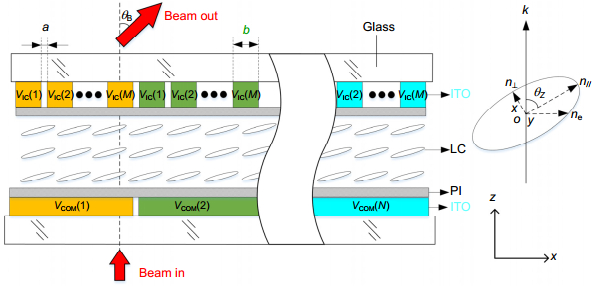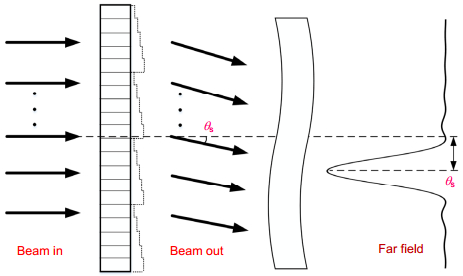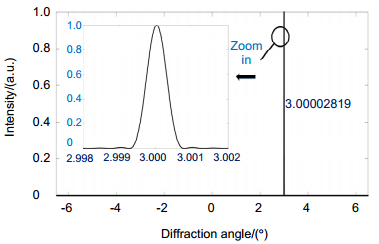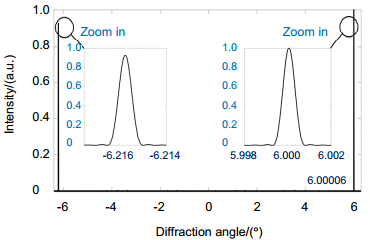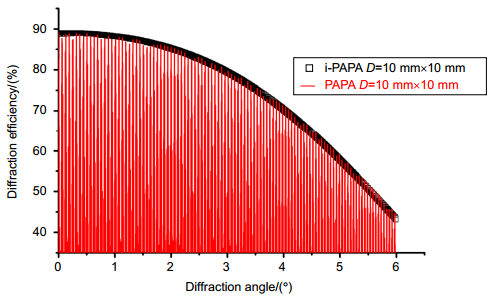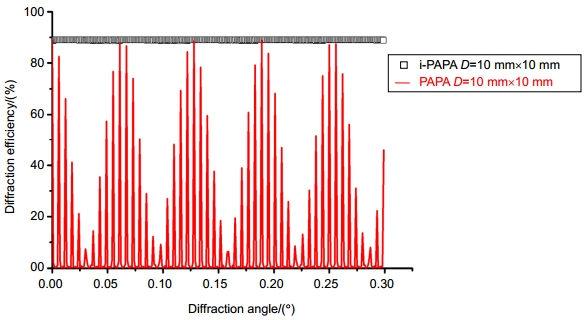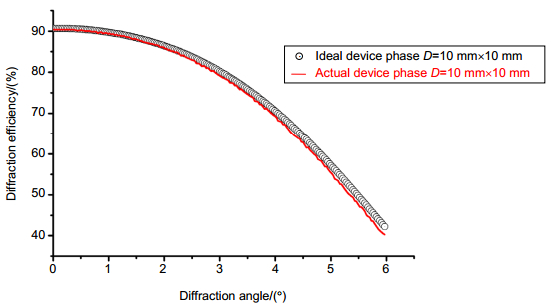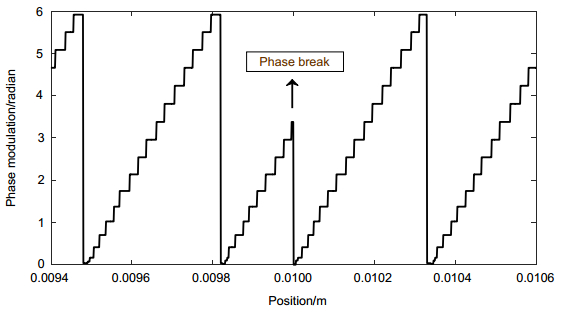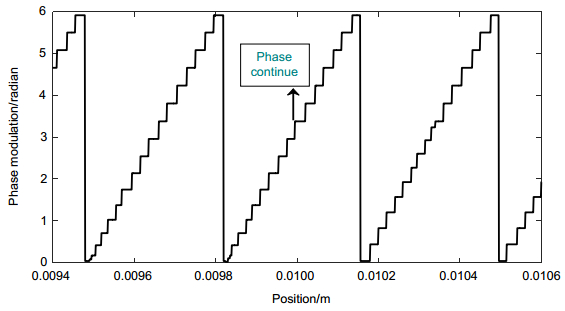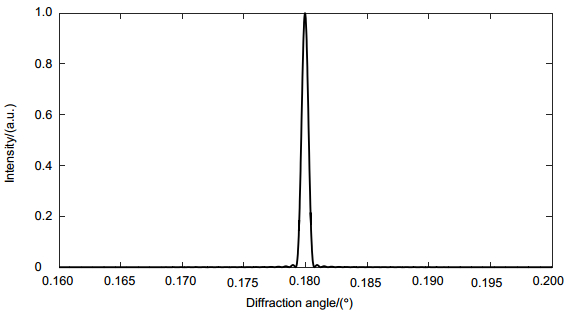The realizable method for large diameter liquid crystal optical phased array and the analysis of its far-field characteristics
-
摘要
天线通光口径是液晶光学相控阵的重要技术指标,本文在多子阵并行驱动和两级器件级联方法(PAPA)的基础上,提出改进型的i-PAPA方法,通过对COM电极进行分区域驱动,在单个相控阵天线上实现大口径相控光束控制,具备单器件工作、插损低等优点。通过数值仿真分析,结果表明:相控阵天线后的近场相位分布连续;当指向角度在0°到+6°范围内,远场衍射效率和指向角度的数值关系呈现平滑单调下降,衍射效率均大于48%;当指向角度在0°到+3°范围内,衍射效率均大于80%。

Abstract
The optical aperture of the antenna is an important technical indicator of the liquid crystal optical phased array. Based on the multi-subarray parallel driving and two-level device cascade method (PAPA), in this paper, an improved i-PAPA method was proposed. Large area phased beam control is realized on a single phased array antenna by subdivision of the COM electrodes, and it has the advantages of single device operation and low insertion loss. Through numerical simulation, the results show that the antenna near field phase has continuous distribution; when the point angle varies from 0 degrees to +6 degrees, the far-field diffraction efficiency drops smoothly and monotonously as the point angle increases, the diffraction efficiency is greater than 48%; When the point angle varies from 0 degrees to +3 degrees, the diffraction the efficiency is greater than 80%.
-
Key words:
- optical phased array /
- liquid crystal /
- large diameter /
- diffraction efficiency
-
Overview

Overview: After entering the 21st century, laser technology has achieved rapid development, especially laser communication, laser radar, laser guidance, laser weapons and many other application scenarios. Optical phased array as the latest beam control technology has become an international research hotspot. With the increase of the optical aperture of the liquid crystal optical phased array antenna, the number of output channels of a commercial driver chip cannot satisfy the demand for hundreds of thousands of array cells. Using a multi-subarray parallel driver and a two-stage device cascade method (PAPA technology), the equivalent implementation of beam control of a large aperture array antenna is a conventional solution. However, this method has the disadvantages of high alignment accuracy, large system insertion loss, and others.
This paper proposes an improved i-PAPA method based on PAPA technology. Its core idea is to extend the single common electrode of the LC phased array antenna to the panel-controlled array electrodes on the basis of the PAPA structure. On the array antenna, a large-aperture liquid crystal optical phased array device with a diameter of larger than 40mm is realized, which essentially integrates phase modulation and phase compensation on a single liquid crystal phased array antenna. Compared to the conventional PAPA method, i-PAPA can reduce the number of phased array devices by half, reducing system insertion loss and heat accumulation, and transferring the alignment process to the device's processing process. The prior art process can meet its requirements, eliminating the need for assembly and alignment of multiple optical components.
Through numerical simulation analysis, the results show that the near-field phase of the adjacent sub-aperture electrodes in the PAPA structure is not necessarily an equal-difference distribution, but an average distribution between 0 and 2π; At a steering angle of 0 degree to 6 degree, the far-field diffraction efficiency follows the diffraction characteristics of blazed binary grating, and the relationship between the diffraction efficiency and the deflection angle of a single device is a decreasing oscillation. The near-field phase of the adjacent sub-aperture electrodes in the i-PAPA structure is always equal-distance distribution. When the steering angle varies from 0 degree to 6 degree, the far-field diffraction intensity follows the phase pattern array angle. The far-field diffraction efficiency and the steering angle are smoothly decreasing. The far-field prime maximum spot exhibits a complete Gaussian distribution with diffraction efficiency greater than 48%. When the steering angle is in the range of 0 degree to +3 degree, the diffraction efficiency is greater than 80%.
-

-
-
参考文献
[1] 赵祥杰.液晶相位控制阵列关键技术及其应用[D].绵阳: 中国工程物理研究院, 2014.
Zhao X J. Key Technology and application of liquid crystal phased array[D]. Mianyang: China Academy of Engineering Physics, 2014.
[2] 杜升平.应用于空间光通信的液晶光束偏转技术研究[D].成都: 中国科学院光电技术研究所, 2017.
Du S P. Research on liquid crystal beam deflection for space optical communication[D]. Chengdu: Institute of Optics and Electronics, Chinese Academy of Sciences, 2017.
[3] 师宇斌.基于液晶相控阵的光束定向跟瞄技术研究[D].长沙: 国防科学技术大学, 2013.
Shi Y B. Study on beam directing, tracking and aiming technique based on liquid crystal phased array[D]. Changsha: National University of Defense Technology, 2013.
[4] 汤镇辉.液晶光学相控阵的波束扫描方法研究[D].成都: 电子科技大学, 2015.
Tang Z H. Target location research based on distributed phased array radar[D]. Chengdu: University of Electronic Science and Technology of China, 2015.
[5] Lin Y H, Mahajan M, Taber D, et al. Compact 4 cm aperture transmissive liquid crystal optical phased array for free-space optical communications[J]. Proceedings of SPIE, 2005, 5892: 58920C. http://cn.bing.com/academic/profile?id=aa42d42da19ebc88b40f8ac757bc90cd&encoded=0&v=paper_preview&mkt=zh-cn
[6] McManamon P F, Bos P J, Escuti M J, et al. A review of phased array steering for narrow-band electrooptical systems[J]. Proceedings of the IEEE, 2009, 97(6): 1078–1096. doi: 10.1109/JPROC.2009.2017218
[7] Sun J, Wu S T, Haseba Y. A low voltage submillisecond-response polymer network liquid crystal spatial light modulator[J]. Applied Physics Letters, 2014, 104(2): 023305. doi: 10.1063/1.4862474
[8] Golovin A B, Shiyanovskii S V, Lavrentovich O D. Fast switching dual-frequency liquid crystal optical retarder, driven by an amplitude and frequency modulated voltage[J]. Applied Physics Letters, 2003, 83(19): 3864–3866. doi: 10.1063/1.1625114
[9] Engstr m D, O'Callaghan M J, Walker C, et al. Fast beam steering with a ferroelectric-liquid-crystal optical phased array[J]. Applied Optics, 2009, 48(9): 1721–1726. doi: 10.1364/AO.48.001721
[10] Chen Y, Yan J, Sun J, et al. A microsecond-response polymer-stabilized blue phase liquid crystal[J]. Applied Physics Letters, 2011, 99(20): 201105. doi: 10.1063/1.3662391
[11] Wang B, Zhang G Q, Glushchenko A, et al. Stressed liquid-crystal optical phased array for fast tip-tilt wavefront correction[J]. Applied Optics, 2005, 44(36): 7754–7759. doi: 10.1364/AO.44.007754
[12] Xu D M, Tan G J, Wu S T. Large-angle and high-efficiency tunable phase grating using fringe field switching liquid crystal[J]. Optics Express, 2015, 23(9): 12274–12285. doi: 10.1364/OE.23.012274
[13] 贺晓娴, 汪相如, 李曼, 等.液晶中波红外光学相控阵关键技术研究进展[J].红外与激光工程, 2016, 45(8): 0830003. http://d.old.wanfangdata.com.cn/Periodical/hwyjggc201608042
He X X, Wang X R, Li M, et al. Research review on mid-infrared liquid crystal optical phased array[J]. Infrared and Laser Engineering, 2016, 45(8): 0830003. http://d.old.wanfangdata.com.cn/Periodical/hwyjggc201608042
[14] Wu L, Wang X R, Xiong C D, et al. Polarization-independent two-dimensional beam steering using liquid crystal optical phased arrays[J]. Chinese Optics Letters, 2017, 15(10): 101601. doi: 10.3788/COL
[15] Tang Z H, Wang X R, Huang Z Q, et al. Sub-aperture coherence method to realize ultra-high resolution laser beam deflection[J]. Optics Communications, 2015, 335: 1–6. doi: 10.1016/j.optcom.2014.08.006
[16] Song Y, Kong L J, Cheng J, et al. Improvement for the steering performance of liquid crystal phased array[J]. Optoelectronics Letters, 2009, 5(3): 177–181. doi: 10.1007/s11801-009-9050-6
[17] Serati S, Masterson H, Linnenberger A. Beam combining using a phased array of phased arrays (PAPA)[C]//Proceedings of 2014 IEEE Aerospace Conference, 2004, 3: 1722–1729.
[18] Wu L, Wang X R, Xiong C D, et al. Design and experimental demonstration on improved high order grating for wide angle beam steering of liquid crystal optical phased array[J]. Proceedings of SPIE, 2017, 10096: 100960Q. doi: 10.1117/12.2249654
[19] 黄子强.液晶显示原理[M].北京:国防工业出版社, 2008: 120–126.
Huang Z Q. Principle of Liquid Crystal Display[M]. Beijing: National Defense Industry Press, 2008: 120–126.
[20] 玻恩M, 沃耳夫E.光学原理(上册)[M].杨葭荪, 译.北京: 科学出版社, 1978: 120–260.
Born M, Wolf E. Principles of Optics[M]. Yang J S, trans. Beijing: Science Press, 1978: 120–260.
[21] 张光义.相控阵雷达原理[M].北京:国防工业出版社, 2009: 20–50.
Zhang G Y. Principles of Phased Array Radar[M]. Beijing: National Defense Industry Press, 2009: 20–50.
-
访问统计


 E-mail Alert
E-mail Alert RSS
RSS
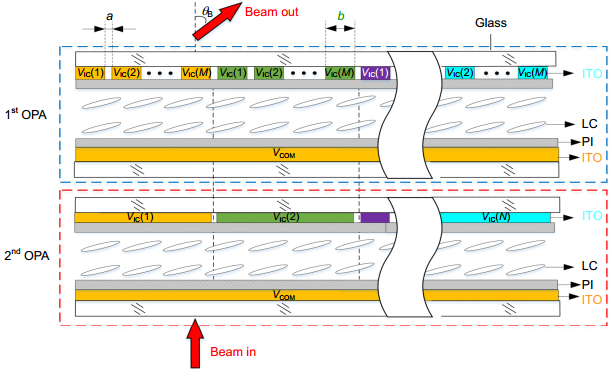
 下载:
下载:
